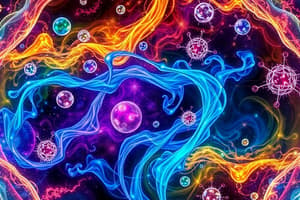Podcast
Questions and Answers
What type of bonds do inorganic compounds typically feature?
What type of bonds do inorganic compounds typically feature?
- Ionic bonds (correct)
- Covalent bonds
- Hydrogen bonds
- Metallic bonds
Which category includes elements like iron, aluminum, and gold?
Which category includes elements like iron, aluminum, and gold?
- Halogens
- Metalloids
- Nonmetals
- Metals (correct)
What type of structures do inorganic compounds often form?
What type of structures do inorganic compounds often form?
- Crystalline lattice structures (correct)
- Glassy structures
- Polymer structures
- Amorphous structures
Which compound is an example of an inorganic compound?
Which compound is an example of an inorganic compound?
What type of elements make up most matter on Earth outside organic life forms?
What type of elements make up most matter on Earth outside organic life forms?
Which type of atoms form covalent bonds in organic compounds?
Which type of atoms form covalent bonds in organic compounds?
What crucial insights does knowledge of crystal structures provide?
What crucial insights does knowledge of crystal structures provide?
Why is diamond exceptionally strong according to its structure?
Why is diamond exceptionally strong according to its structure?
Which industry benefits from inorganic chemistry through the use of semiconductors and batteries?
Which industry benefits from inorganic chemistry through the use of semiconductors and batteries?
What can be a potential application of metal-organic frameworks (MOFs) developed by inorganic chemists?
What can be a potential application of metal-organic frameworks (MOFs) developed by inorganic chemists?
Why is sodium chloride transparent?
Why is sodium chloride transparent?
What futuristic advancements have been made by inorganic chemists according to the text?
What futuristic advancements have been made by inorganic chemists according to the text?
Flashcards are hidden until you start studying
Study Notes
Discovering the World of Inorganic Chemistry
In this journey through chemical landscapes, we'll delve into the realm where elements dance with one another in patterns beyond those found within living beings—inorganic chemistry. Here, metals, nonmetals, and their compounds come alive to form complex structures and reveal fascinating properties. Let's explore the fundamental principles and intriguing phenomena that characterize our subject.
Elements & Their Classification
Inorganic chemistry deals primarily with the 98 naturally occurring elements that make up most matter on Earth outside organic life forms. These fall under two broad categories: Metals, like iron, aluminum, and gold; and Non-metals, such as carbon, oxygen, and halogens. Metalloids, which exhibit traits from both sides, complete the trio.
Bonds & Compounds
Unlike the covalent bonds formed between atoms in organics, inorganics typically feature ionic bonds arising from electrostatic attractions between positively charged metallic ions and negatively charged non-metal ions. This results in the formation of crystalline lattice structures known as salts.
These connections become apparent when viewing the Periodic Table, revealing familiar compounds like sodium chloride (NaCl), calcium sulfate (CaSO₄), copper oxide (CuO), and hydrogen phosphate (HPO₄⁻²).
Crystal Structure & Properties
Most inorganic compounds exist as crystals due to their characteristic repeating arrangements of atomic units. Knowledge of crystal structures is crucial because it provides insight into various material properties like conductivity, hardness, and density. For instance, diamond's exceptional strength is attributed to its three-dimensional network structure, while sodium chloride's characteristic transparency is due to its highly ordered molecular arrangement.
Applications Across Industries
Due to the wide range of materials available and their unique properties, inorganic chemistry has numerous applications across industries, including construction (cement, ceramics), electronics (semiconductors, batteries), energy production (fuels, solar panels), environmental remediation (catalysts, water treatment), medicine (radiopharmaceuticals, imaging agents), and many more.
A Futuristic Outlook
With ever-evolving technologies pushing the boundaries of science, inorganic chemists continue exploring new frontiers. Recent advancements have led to the development of novel materials such as perovskites, metal-organic frameworks (MOFs), and graphene derivatives, paving the way for revolutionary breakthroughs in areas like renewable energy storage, gas separation, and advanced sensing technology.
Studying That Suits You
Use AI to generate personalized quizzes and flashcards to suit your learning preferences.



